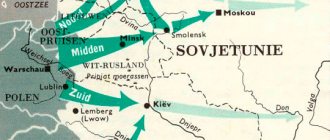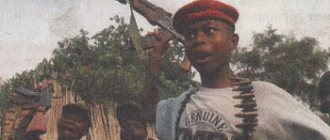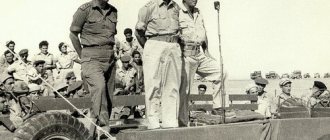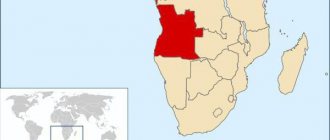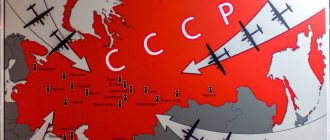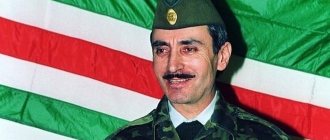“There are no fortresses that the Bolsheviks could not take.”
I.V. Stalin
“In that unknown war...”
A. Tvardovsky. "Two lines."
“Stalin needed to find a good reason to start his liberation campaign. Otherwise, the world community would begin to call us “bloody warmongers.” And Joseph Vissarionovich came out of this situation brilliantly. It was announced that the Finnish government was preparing a crusade against Bolshevism,” argues Armen Gasparyan on Radio Mayak (broadcast from 2005/17/09 | 22:10).
“The Soviet Union sought to absorb the former part of the Russian Empire, and at the same time show strength and power.” And this is what P.B. says about the “true” causes of the war. Lipatov (Winter War. M., 1996, p. 174).
Shutskor during exercises, 1936
That's it... The bloody regime of the “Kremlin highlander” simply decided to enslave small and defenseless Finland, to carry out its brilliant “blitzkrieg”, but the Red Army, decapitated by repressions, fought the war ineptly. The peaceful Finns, briefly tearing themselves away from their reindeer pastures, slaughtered the Red Army soldiers like sheep, surrendering at every opportunity. As a result, the losses of the Red Army were almost ten times higher than those of the enemy...
The current press likes to practice on the topic of that “unfamous” war, savor our losses, and at the same time canonize Marshal Mannerheim. He loved Russia too, and did not want to fight with the Soviet Union, and practically saved Leningrad by stopping his troops on the old Soviet-Finnish border. And not a word about the heroism of Soviet soldiers, the true reasons for the outbreak of the war and the lessons learned!
In a small study presented to your consideration, the author tried to briefly trace the dramatic history of relations between Finland and Russia, show the objective reasons for the inevitability and, no matter how cynical it may sound, the expediency of the Soviet-Finnish war, and also, if possible, focus the attention of respected readers on the feat of the Red Army, which it accomplished in the snows of the Karelian Isthmus...
Neighbors, but not friends
The centuries-old history of relations between Russia and Finland has never been simple. The ancestors of the modern Finns are the tribes that inhabited the territory of modern Finland, and the ancient Russians carried out constant raids and military campaigns in adjacent territories. Apparently, at least from the 9th century, Finnish tribes began to pay tribute to the Rus, and by the middle of the 11th century, the entire territory of modern Finland paid tribute to Veliky Novgorod.
In 1042, Vladimir, the son of Yaroslav the Wise, once again defeated him and agreed with the Swedes on the border along the Kymi River (present-day Kymijoki in the vicinity of the city of Kotka). The campaign of Vsevolod, the son of Vladimir Monomakh, against the Sumy tribe dates back to 1120.
Modern map of Finland
At the same time, the Swedes also tried to strengthen their positions in Finland.
Finnish historians count three crusades undertaken by Sweden in Finland: in 1155 to western Finland, in 1239 (or 1249) in Häma and in 1293 to Karelia.
The last campaign of the Swedes was, perhaps, the most successful - the Swedish Jarl Torgels Knutsson equipped a powerful fleet, gathered a large army and reached the Karelian Isthmus. The Swedes managed to defeat the Novgorodians, local Orthodox Karelians were baptized into the Catholic faith and in the same year they founded the Vyborg fortress. In 1300, at the mouth of the Neva River, the Swedes built the Landskrona fortress, the “Crown of the Earth,” but the very next year, as the Novgorod chronicle narrates, the Russians “burned and raked” it, and “beat and cut down” the defenders...
In 1318, Russian troops captured and burned Turku; military raids continued regularly. In 1323, for the first time, the Orekhov Treaty defined the border between Russia and Sweden. Novgorod recognized Swedish power over western Karelia, retaining the city of Ladoga and the Ladoga lands. As a result of the Crusades, Finland itself was finally annexed to Sweden, and the city of Turku became its administrative and religious center.
In the 16th century, the Karelian Isthmus became one of the “fronts” of the grueling Livonian War, in which Sweden took an active part. In particular, in 1581 the Swedes occupied Korela (now Priozersk).
In the 17th century, during the events of the Time of Troubles, the Swedes captured territories adjacent to the Neva. They managed to occupy Novgorod, Ladoga and Ingria lands. The severe consequences of the Time of Troubles were also reflected on the Finnish border. The Treaty of Stolbovo in 1617 deprived Russia of access to the Baltic Sea, and Sweden gained a dominant position in the Baltic.
Only in 1721, after the victorious Northern War, Russia regained its lost lands, which were abundantly watered with the blood and sweat of Russian soldiers, pioneers, peasants and artisans. According to the Treaty of Nystadt in 1721, lands on the southern coast of the Gulf of Finland, the Neva, Vyborg and Priozersk were annexed to Russia. Russia gained access to the Baltic, and Sweden lost its former power.
The Swedes did not accept their losses. In 1741, another war was declared on Russia. The new Peace of Abo in 1743 pushed the border another 60 kilometers deeper into Finland to the Kymijoki River, and the Finnish cities of Neishlot (Savonlinna), Friedrichsgam (Hamina) and Vilmanstrand (Lappeenranta) were annexed to Russia.
Per Evind Svinhuvud (1861-1944) - Finnish politician, President of Finland in 1931-1937
Russian Finland
In 1809, after the last war with Sweden, according to a treaty concluded in the city of Friedrichsgam (Hamina), the entire territory of Finland, together with the Åland Islands, became part of the Russian Empire. At the same time, Alexander I annexed (or simply donated) the Vyborg province to the Grand Duchy of Finland. All lands up to the Sestra River went to the Finnish principality. The principality enjoyed the broadest autonomy and great privileges, which it could not even imagine under the rule of Sweden. Thus, military service did not apply to him; the principality had a completely autonomous police force. The Finnish language and culture began to flourish. In 1897, the average life expectancy of Finns in the Russian Empire was about 45 years, for Russians - 29 years.
But there were also obvious “excesses on the ground.” For example, Russians, coming to Finland, felt like they were abroad: already on the train departing from the Finlyandsky Station in St. Petersburg, the conductors did not speak Russian. In Finland, rubles were not accepted for payment; at the border it was necessary to undergo customs inspection. It was impossible to find out the news - there were no newspapers in Russian! Finn could have entered the civil service in Russia and made a career, as the future Marshal of Finland K.G. Mannerheim. And a native of Russia did not have the right to hold a position in the management structures of the Grand Duchy of Finland.
Of course, this could not continue for long - that’s what the empire is for, to bring everyone “to a common denominator,” and at the end of the 19th century, Nicholas II tried to change the existing order. Finnish historians call the end of the 19th and beginning of the 20th centuries “the time of persecution” (Finnish: sortokaudet/sortovuodet). This meant the gradual Russification of Finland, bringing Finnish laws into line with Russian ones and tightening administrative control on the territory of the Grand Duchy.
In 1899, Nicholas II signed a manifesto, according to which the Finnish parliament lost the right to make laws. A year later, Finnish government institutions started speaking Russian. A year later, Finns began to be drafted into the Russian army (separate Finnish armed forces were liquidated and included in the army of the Russian Empire). Those who refused to serve were forced to pay a special tax. The indignant Finnish newspapers were closed.
The result was the murder in 1904 of Governor General N.I. Bobrikov, who carried out unpopular reforms. A year later, a wave of strikes swept across Finland, the Finns demanded the return of the old Swedish laws (!) and an end to the imposition of Russian orders.
First government of Svinhufvud, 1917
Nicholas II, exhausted by the unsuccessful Japanese war and the February revolution of 1905, returned the old laws to Finland and established, along with the Russian State Duma, the Parliament of Finland, replacing the old four-estate Sejm.
The first elections to the Finnish parliament were successful - 200 deputies were elected, who immediately began to discuss and criticize the new imperial order, in particular, the statement of Nicholas II that Finnish laws should be published in Russia. Having dealt with uprisings and strikes, Nicholas II dissolved the Finnish parliament in 1910 for the words of Per Evind Svinhufvud that Russia was violating the laws of Finland, which the emperor swore to observe upon ascending the throne. Svinhufvud himself, the future third president of Finland, was exiled to Siberia...
A revolution, the necessity of which...
Choosing a very opportune moment, when the territory of the Russian Empire was ready to “burst at the seams,” and German troops were advancing from the West, immediately before the October Revolution—October 23 (November 5), 1917—the Finnish Sejm proclaimed Finland an independent state. On November 15 (NS) 1917, the Finnish parliament declared itself the supreme authority of the country and elected an independent government led by Svinhufvud. Two weeks after the creation of the independent government, Svinhufvud prepared the Declaration of Finnish Independence and on December 6 (NST) the Finnish parliament approved it.
It would seem, what is Finland - a land of forests and lakes, most of whose territory remains practically undeveloped to this day? It is quite obvious that the territory of the Grand Duchy of Finland was of enormous military and strategic importance for Russia. There were garrisons, coastal batteries, and naval bases here. During World War I, the coast of the Karelian Isthmus, Finland and the southern coast of the Gulf of Finland were the most powerful coastal defense lines, covering the capital of the empire and Kronstadt with their batteries. It was the most important outpost of our north-west, the battle for which was fought for centuries...
But history does not tolerate the subjunctive mood, and what had to happen happened. Finland, always under someone's rule, finally gained independence. This time from “Russian oppression.” Russia, tormented by war and internal strife, unable at that moment either ideologically or physically to prevent the establishment of Finnish independence, was forced to make concessions to the obstinate fiefdom. On December 18 (31), 1917, the Council of People's Commissars of the RSFSR decided:
“Enter the CEC with a proposal:
- recognize the state independence of the Republic of Finland and
- organize, by agreement with the Finnish Government, a special Commission of representatives of both sides to develop those practical measures that arise from the separation of Finland from Russia.”
The first raising of the Finnish flag over the roof of the Senate on June 16, 1918
The resolution was also signed by I.V. Stalin was then People's Commissar for Nationalities...
What's next? It seems that everyone got what they wanted - live and be happy, but the subsequent relations of Soviet Russia (and later the Soviet Union) with Finland developed even more dramatically...
Who benefited from the provocation?
The Finnish War of 1939-1940 began with shelling at Mainila. Who benefited from this? Historians are still arguing, highlighting several reasons:
- The Finns were a political tool of the British who wanted war. The assumption would make sense if the Second Finnish War were separate. But at that time the Second World War was already underway, and England at that time declared war on Germany. If England attacked the USSR, it would automatically create an alliance between Hitler and Stalin, which would sooner or later hit the British themselves. For this reason, such an assumption could mean that England decided to commit suicide, which is not true.
- The Finns wanted to expand their lands and increase their influence on the world stage. We have already briefly examined the causes of the Finnish War, from which it follows that the hypothesis is meaningless. Finland did not have the strength and means to wage war. The country's command understood that success was possible only if the enemy was exhausted by a long defense. The state would not voluntarily become involved with such a powerful enemy.
The most logical answer is that the Soviet Union itself carried out the shelling in order to have a reason to start a conflict. Subsequently, the Soviet authorities presented this event to ordinary citizens as an example of the treachery of the Finnish people. The party convinced soldiers and civilians that Finland needed help to carry out a socialist revolution.
“White Finns” - an invention of Soviet propaganda or objective reality?
The situation in Finland was heating up. In the wake of the revolution in Russia, the discontent of the masses grew, the local “reds” became more active - and there were many of them. On January 9, the Svinhufvud government authorized the command of the Shutskor - the “White Guard” (a little more about the Shutskor will be discussed later) to restore public order in the country.
On January 12, the Seimas adopted laws granting the government emergency powers and taking the government into state custody.
Soon the “white” detachments took control of the cities of Vasa, Kauhava and Seinäjoki. At the same time, White Finnish detachments began to seize the Vyborg-Sortavala-Joensu railway. On January 26, the 27th Finnish Jaeger Battalion (2 thousand people), formed in Germany and delivered from Kiel by ships of the German fleet, landed in Vasa.
On the night of January 14 (27) to January 15 (28), the armed uprising against the Svinhufvud government was victorious in Finland; on January 27, detachments of the Finnish Red Guard occupied government offices and banks in Helsinki.
On January 29, a government was formed - the Council of People's Representatives (SNU), which signed several agreements with the government of the RSFSR. The left wing of the Social Democratic Party seized power in Helsinki and proclaimed the Finnish Workers' Socialist Republic. The government of Svinhufvud fled to the city of Vasa, in which the troops of Baron Carl Gustav Mannerheim, who had recently been appointed commander-in-chief of the Finnish army, disarmed the small Russian garrison.
Finnish Civil War 1918 Red Finns
The Finnish Civil War (Suomen sis llissota) was short-lived and bloody. At the same time, Germany helped Finland, and Soviet Russia helped the “red” Finns. Both sides had their own reasons for this. It was more than beneficial for the former to support separatist sentiments on the territory of the former Entente member; Russia also could not help but make an attempt to direct Finland along the socialist path.
The “white” Finns did not limit themselves to sorting out relations only within their own country. “On the quiet,” one could try to grab a considerable piece from Russia, which was greatly weakened at that moment. In January 1918, Finnish armed detachments began to penetrate into the territory of the RSFSR in the direction of the cities of Ukhta and Kem, with the aim of occupying Eastern Karelia. At the end of March, the Finns captured the Soviet icebreakers Tarmo and Volynets, heading to Helsingfors (then still in the hands of the Reds), and fired at the icebreaker Ermak. At Mannerheim's headquarters, a plan was developed for organizing a national uprising in Eastern Karelia. In March, Mannerheim signed an order to set out three invasion groups to conquer Eastern Karelia (the so-called “Wallenius plan”) along the line Petsamo - Kola Peninsula - White Sea - Lake Onega - Svir River - Lake Ladoga. Mannerheim also put forward a plan for the liquidation of Petrograd as the capital of Russia and the transformation of it and adjacent cities (Tsarskoe Selo, Gatchina, Peterhof, etc.) into a “free city republic.”
Things got to the point that on May 5, 1918, pursuing the retreating Red Finnish detachments, the Finnish army crossed the border, hoping to immediately enter Petrograd. The offensive was carried out from Sestroretsk and along the Finnish Railway. By May 7, the offensive had stalled, and units of the Red Guard pushed the enemy back beyond the border of the Vyborg province.
The winners unleashed mass terror in their own country. According to various estimates, about 8-9 thousand people were executed (according to other sources, in Fort Ino alone, on the direct orders of Mannerheim, up to 10 thousand “enemies of the regime” were executed), up to 13 thousand died in concentration camps...
First Soviet-Finnish
The failure to attack Petrograd did not stop the Finns, but seemed to provoke them even more. On May 15, the Finnish government declared war (!) on the RSFSR (while the next day, Mannerheim officially announced the end of the civil war in the country (01/27-05/16/1918)).
On May 22, at a meeting of the Finnish Sejm, deputy Rafael Woldemar Erich (future Prime Minister) said: “Finland will sue Russia for losses caused by the war (meaning the civil war - D.K.). The size of these losses can only be covered by the annexation of Eastern Karelia and the Murmansk coast to Finland.”
Civil War in Finland 1918. White Finns, officers, on the Karelian Front (Karelian Isthmus)
Germany officially offered its services as a mediator in concluding peace between the RSFSR and Finland. After all, shortly after the signing of the Brest-Litovsk Peace Treaty, Kaiser Wilhelm II stated that he would not fight for Finnish interests with Soviet Russia and would not support Finland’s military actions if it moved them beyond its borders. There is a version that it was under pressure from Germany that on May 31, 1918, Mannerheim, who was oriented towards the Entente, resigned. This automatically led to the fact that his order to start a war with the RSFSR practically ceased to be valid just two weeks after its publication.
The Svinhufvud government, which had obvious pro-German sentiments, thanks to the intervention of Germany, which pursued its goals in the struggle in the North against the Entente, did not take decisive action against the RSFSR for quite a long time. Only on October 15, 1918, the Finns occupied the Rebolskaya volost in Eastern Karelia.
(It is interesting to note that on October 9, 1918, the Diet elected Frederick Charles of Hesse, brother-in-law of Wilhelm II, as King of Finland. The unlucky ruler of Finland did not even have time to get to his allotment - on November 11, 1918, the Compiegne Armistice was signed, and on November 28, the commander of the eastern front was an order was given to evacuate German troops from Finland and other territories of the former Russian Empire.)
In December 1918, a new Finnish government was formed, focused on the Entente countries (regent K.G. Mannerheim) - primarily on England and France.
It would seem that the Finns would not benefit from a victory in Russia by monarchists or other forces that would not treat Finnish independence “with understanding.” Nevertheless, at the beginning of 1919, the Finns had an agreement with the command of Yudenich’s White Guard Northwestern Army on joint military operations against the Bolsheviks. In January 1919, Finnish troops occupied the Porosozernaya volost (adjacent to Rebolskaya), and in April 1919 the so-called Olonets Volunteer Army went on the offensive. Almost simultaneously, in May, Yudenich’s troops began an attack on Petrograd.
In addition, Finland acted openly and jointly with the British interventionists. Thus, the Bjerke Sund base, located 35 km from Kronstadt, was provided to the Royal Navy. It was from there that the famous raid of British torpedo boats and aircraft (from the Vindictive air transport) on Kronstadt on August 18, 1919 was carried out with the aim of destroying the combat core of the Soviet Baltic Fleet.
The internal war ended in victory for the Whites, thanks to the support of Germany. Mannerheim held a victory parade in Helsinki on May 16, 1918
Having captured part of South Karelia, including the city of Olonets, Finnish units approached the capital of Karelia, Petrozavodsk. A critical situation has arisen. At the same time, Anglo-Canadian troops and White Guard units were advancing from the north in the direction of Kondopoga - Petrozavodsk. Fierce fighting broke out on the approaches to Petrozavodsk, as a result of which the Finnish offensive was temporarily suspended.
During the Vidlitsa operation from June 27 to July 8, Finnish troops were defeated and driven back from Soviet territory.
The Vidlitsa operation began with a combined attack on Lake Ladoga by the Onega military flotilla, reinforced by 2 destroyers, and from land - by units of the 1st Infantry Division along with the 1st Soviet Finnish Regiment. Having suppressed the enemy batteries with ship fire, the flotilla landed troops at the mouth of the Vidlitsa and Tuloksa rivers, which liberated the villages of Vidlitsa and Tuloksa, and then, together with units of the 1st division, drove the White Finns across the state border.
The Olonets section of the Karelian Front was completely liquidated: Finnish troops retreated beyond the border line. However, the Finnish government refused to negotiate.
In August, the actions of the Finns and British interventionists in Zaonezhie intensified again, and the Karelian Front re-emerged. But the enemy was defeated during the Lizhem operation (September 26-27), and by mid-February 1920 the Karelian Front had stabilized and the battles had acquired a positional character.
Finally, after on May 18, 1920, units of the Red Army liquidated the so-called North Karelian state with its center in the village of Ukhta (Arkhangelsk province), which received financial and military assistance from the Finnish government, and by July 21, 1920, they drove out the Finnish armed forces from almost all territory of Karelia, with the exception of the Rebolsky and Porosozersky volosts, the Finnish government agreed to resume peace negotiations.
On October 14 of the same year, the Yuryevsk (Tartus) Peace Treaty was concluded.
Poster from the Second Soviet-Finnish War of 1921-22
According to the treaty, the state of war ended upon the entry into force of the treaty, that is, from December 31, 1920 (2.5 months after its conclusion) - an unprecedented fact in the history of international agreements.
The entire Pechenga region (Petsamo), as well as the western part of the Rybachy Peninsula and most of the Middle Peninsula, went to Finland in the North, in the Arctic. All islands west of the demarcation line in the Barents Sea also went to Finland. The border on the Karelian Isthmus was established from the Gulf of Finland along the Sestra River and then went north along the line of the old Russian-Finnish border, which separated the Grand Duchy of Finland from the Russian provinces proper. The Karelian volosts of Repola and Porosozerskaya, occupied by Finnish troops, were cleared of troops and returned to the Karelian Labor Commune (later the Karelian Autonomous Region).
This is how this conflict ended, which historians call the “First Soviet-Finnish War”...
Expulsion of the USSR from the League of Nations
On December 14, 1939, the USSR was expelled from the League of Nations. This decision was promoted by England and France, who spoke of Soviet aggression against Finland. Representatives of the League of Nations condemned the actions of the USSR in terms of aggressive actions and the outbreak of war.
Today, the exclusion of the USSR from the League of Nations is cited as an example of the limitation of Soviet power and as a loss in image. In fact, everything is a little different. In 1939, the League of Nations no longer played the role it had been assigned following the First World War. The fact is that back in 1933, Germany left it, refusing to comply with the demands of the League of Nations for disarmament and simply left the organization. It turns out that at the time of December 14, the League of Nations de facto ceased to exist. After all, what kind of European security system can we talk about when Germany and the USSR left the organization?
Second Soviet-Finnish
On November 6, 1921 (11/06/1921), Finnish troops invaded the RSFSR - the second Soviet-Finnish War began.
At this time, the so-called “Provisional Karelian Committee” was actively operating on the territory of the RSFSR. His troops carried out a series of sabotage attacks on individual objects and settlements in Karelia (the railway bridge over the Onda, the village of Rug-Ozero), aimed at destroying party activists there. Finnish detachments, numbering 5-6 thousand people, managed to advance to the line Kestenga - Suomusalmi - Rug-ozero - Padany - Porosozero. This became possible due to the fact that units of the Red Army, according to the peace treaty, were withdrawn from the border areas, and the weak barriers of the border guards were unable to hold back the Finnish advance.
Ski battalion of the Petrograd International Military School (formed from former members of the Finnish Red Guard who emigrated to the RSFSR after defeat in the Finnish Civil War) on the Karelian Front, 1922.
By the end of December, significant forces of the Red Army were transferred to Karelia; with a blow from Petrozavodsk, Soviet troops occupied Porosozero, Reboly and Kamasozero by the beginning of January 1922, defeating the main group of Finns.
On January 25, the northern group of Soviet troops occupied Kestenga and Kokisalma, and in early February they occupied the military-political administrative village of Ukhta. Thus, by mid-February 1922, the border areas were completely cleared of the aggressor. Units from the Red Finns who emigrated to the RSFSR after the Civil War in Finland, in particular the ski battalion of the Petrograd International Military School (commander A.A. Inno), took a large part in the defeat of the White Finnish troops.
On March 21, 1922, the “Agreement between the governments of the RSFSR and Finland on taking measures to ensure the inviolability of the Soviet-Finnish border” was signed in Moscow, which replaced the peace treaty. The “Second Soviet-Finnish War” ended. On the border with Finland, there was a tense, but still calm...
January: “boilers”
In January 1940, the position of Soviet troops north of Ladoga became even worse.
In the first days of this month, Hegglund encircled (in the Lemetti-Uoma-Kittel area) the entire left flank group of the 8th Army - the 18th and 168th divisions and the 34th light tank brigade. And the 9th Infantry Division (Colonel Hjalmar Siilasvuo) from the Tuompo group in the Suomussalmi - Raate area - the 44th Division of the 9th Army.
By January 7, the 44th managed to escape from the “cauldron”, but, having lost all the heavy weapons and a lot of people killed, frozen and captured, it lost its combat effectiveness.
In mid-January, Hegglund began the systematic dismemberment and destruction of the encircled formations of the 8th Army.
And at the end of the month, units of Siilasvuo transferred to the south surrounded and dismembered another division of the 9th Army - the 54th - in the Kuhmo area.
But at the same time, the North-Western Front of Army Commander 1st Rank Semyon Timoshenko (who united the 7th and 13th armies on January 7) was preparing to storm the “Mannerheim Line”. Its main sections were reproduced in the Soviet rear, and the infantry learned to advance on them behind the tank, behind the barrage of fire, and to block pillboxes.
The artillerymen realized that they needed to hit the pillboxes with direct fire, aiming for the embrasures. The concrete will remain undestroyed, but the pillbox will remain silent.
The army learned from its bloody mistakes.
Long before the new world war
A bad peace, as we know, is better than a good quarrel, but during 18 peaceful years, nationalist and anti-Russian sentiments in Finland not only did not subside, but, on the contrary, only intensified. Thus, the President of Finland Svinhufvud (1931-1937), under whom Soviet Russia recognized the independence of the Finns, stated: “Any enemy of Russia must always be a friend of Finland.” Helsinki had no intention of abandoning plans to create Finland “from the Gulf of Bothnia to the Pacific Ocean and from the White Sea to the Black Sea,” which would include at least the Kola Peninsula and Karelia. There were also new followers of the popular Finnish writer Juhani Aho (1861-1921), who dreamed of a Russian Alexander the Great, who would one day turn to dust the power of the new Persia, that is, Russia, and create Great Finland on its territory.
Since 1929, a wave of the so-called “Lapua movement” - Finnish fascism, arose in Finland, the participants of which, speaking under the slogan of “destruction of communism,” aimed to suppress the protests of the working class, incited anti-Soviet sentiments and hostility towards the national minorities of Finland.
True, in February 1932, in the city of Mäntsälä, the Lapuans attempted an armed rebellion, and in March of the same year, the Lapua movement was officially banned by the government.
Congress of the Lapua movement, March 15, 1930
Nationalist sentiments were also strong among the Shutskor members (by the way, it was the Shutskor members who took part in the first performances of the Lapuans). Shutskor (Swedish skyddskar - security corps; Finnish suojeluskunta) is a paramilitary organization, units of which began to spontaneously arise in Finland in 1917. They were recruited from volunteers opposing the Finnish Red Guard, Russian units leaving Finland.
By decree of September 16, 1921, the organization officially became known as Suojeluskntajarjesto and was subordinated personally to the president. She received the right to have her own uniform, insignia and weapons. On December 22, 1927, the Shutskor was declared an auxiliary part of the country's armed forces, and during the reorganization of the defense forces it received a permanent assignment to organize military training for reservists. There was a women's organization of shutskor ("Lotta Svyard", founded on February 28, 1919), and children's detachments were created in 1929.
In 1939, on the eve of the war, the Shutskor forces numbered over 111 thousand people, another 30 thousand teenagers were in the youth department of the organization. Lotta Svärd had about 105 thousand members and about 24 thousand “little lottas”. During the “Winter War” the Shyutskorites took an active part in the hostilities.
"Peasant March" on Senate Square in Helsinki - a symbol of the triumph of the Lapua movement
The first salvos of the new war were still very far away, but the world was already steadily sliding into its mouth. Western countries have already managed to recover from the horrors of the First World War. Britain, a huge colonial empire, quite seriously laid claim to world domination - the most powerful navy in the world! France, the strongest land army in Europe (as they thought then) was not far behind! From the ashes of the Treaty of Versailles, Hitler's Third Reich was already rising... The position of the Soviet Union on the northwestern borders by the end of the 30s had become very precarious. The border of Finland, which was far from friendly (as previous years had shown), was only 32 km from Leningrad, one of the largest industrial centers of the USSR, and 20 km from Kronstadt, the main naval base of the Baltic Fleet. Both Leningrad and Kronstadt could be fired upon by long-range artillery from Finnish territory and were under direct air attack. The network of military airfields near the borders of the USSR was capable of receiving 10 times more aircraft than the Finnish Air Force. It was also easy for the Finns to cut the railway connecting Leningrad and Murmansk.
In the event of war, the Red Banner Baltic Fleet found itself locked in the Gulf of Finland and did not have the opportunity to enter the operational space in the Baltic Sea. Red Banner Baltic Fleet ships could leave Kronstadt to the West only along the so-called Big Ship Fairway - between the islands of Bolshoi Berezovy, Seskar, Lavensaari, Narvi, Sommers, Gogland and Bolshoi Tyuters. Owning the indicated islands and relying on the skerry areas, the enemy could set up minefields in the indicated area and block the Red Banner Baltic Fleet ships from going to sea. In addition, on Bolshoy Berezovy Island there was a battery of 254 mm guns, which practically blocked the passage between it and Seskar Island. Gogland Island was not armed, but it also had the possibility of installing artillery batteries. Finnish skerries provided the opportunity to attack Soviet ships throughout the Gulf of Finland, and the western exit from the bay to the open sea was under attack by forces based in the skerries area of the Åland archipelago. There was also a threat of a unification of the forces of Finland and Estonia with the subsequent installation of batteries on islands far out to sea, both from Finland and from Estonia. Subject to the interaction of the armed forces of both countries, a powerful artillery position was formed on the Naisaar-Makiluoto island line, covering the entire width of the Gulf of Finland on this line with artillery fire.
It is clear that Finland no longer thought about an independent campaign against the USSR, but it met with support from other countries, relations with which we also had far from rosy, and could be considered by them as a springboard for the deployment of their forces. In particular, in the land theater of operations with the outbreak of hostilities, one of the possible developments was that, having imposed war on the USSR, it was planned to stop the Red Army on the Mannerheim Line, and then, waiting for the approach of the expeditionary forces of Western countries, then go on the offensive. It was assumed that, relying on a system of defensive structures, the Finnish army would be able to hold out without outside help for at least 6 months. Remember this number.
Shyutskorites, 20s
Means and forces
The winter war with Finland of 1939-1940 began with unequal forces. The two countries had different capabilities, and this is not surprising. The Soviet Union had twenty-one times more aircraft than Finland, and artillery was five times greater than the Finnish one. The number of tanks was forty-nine times greater, only the number of infantry troops was approximately the same. Nevertheless, Soviet troops went on the offensive, although the enemy’s superiority was insignificant. It was a risky undertaking, and in order to win, it was necessary to gather all the training, organization and discipline into a single fist. It was precisely these moments in the Soviet army that were imperfect. All this once again confirms that Finland was not an enemy for the USSR; Stalin expected to win a victory in a short time.



